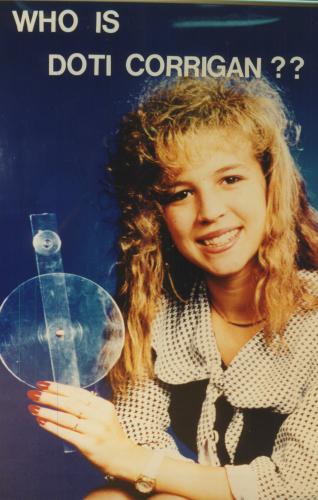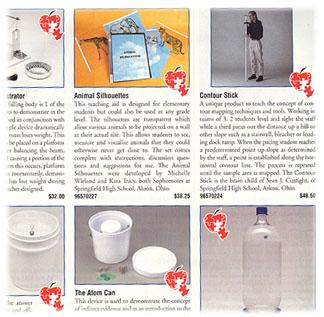I’ll bet I know what you plan to do after you read this sentence.
You plan to scan the article, not bothering to read most of it, and find out just who Doti Corrigan is. So, who is Doti Corrigan? To answer that question, I must share two experiences from my first years in teaching.
Those lab coats...
In 1970, while teaching science at Lakewood High School, in Lakewood, Ohio, two of my students began arguing over who would get to wear a white lab coat that hung in the lab. I was puzzled why each of them was so determined to wear the dingy old thing. But, over time, I observed that whoever did wear this garment always acted differently. They would put pens in the pockets, take better measurements, ask better questions, and generally conduct themselves in a more conscientious manner.
The next year, as an experiment, I ordered enough lab coats for the entire class. I allowed them to wear the coats some days but not others, and observed the effect. When the students wore the lab coats, their performance was consistently better than on the days when they did not. I knew then that I was on to something, but what? Was the secret to successful science education to buy everyone a white lab coat? If so, did it follow that America’s answer to low math scores was to supply every student with a vinyl pocket protector? (I never did get the math teachers to test this latter hypothesis.) These thoughts simmered on my mental back burner for nearly twenty years, until the day someone handed me a piece of plastic pipe.
A local fiber optics company presented my students with the challenge of solving a genuine business problem. It involved designing a more efficient method for moving fiber optic cable through lengths of plastic conduit. When presented with the opportunity to tackle this problem, their response was overwhelming. Never before did my class have the opportunity to do something that would have a genuine impact upon the business (i.e., "real") world. And then it hit me. The fiber optic cable was the reality that the white lab coat had merely symbolized.
The Bottom Line is this: Students want reality, not mere simulation.
How many times have you heard a student ask, "Why do I need to learn this?" And you responded with, "It’s important. You’ll use it later." What if we applied the same logic to coaching sports? What if a high school sports team practiced every day, every week, every year? What if there were never any real games, only real practices? Would coaches honestly expect their teams to "make a good showing", even after four years of practice? Of course not! Yet, in school systems across the country, this is exactly what educators are saying to students: "Learn this today; you’ll need it tomorrow."
For too many students, tomorrow never arrives. They fail to make a connection between what is taught in the classroom and what is used in the real world. We try to motivate students using every available means except the very one that we know works with adults, namely, payment for services rendered. Intellectuals enjoy learning for learning’s sake, but what percentage of today’s students are intellectuals? Many students are heard to say, "I can’t wait to get out of school so that I can start making some money." Yet, ironically, their ability to earn money is based largely on what they learn in school. It’s the delay between learning and earning that hinders many of today’s students from getting the most from their education.
Bottom line #2: Learning equals earning!
Unfortunately, too many students learn this truth only after they have graduated...or dropped out. That’s too late. Of course, just giving money to students for high test scores is not the answer. There are many ways for kids to earn more money, and more quickly, than by just getting good grades. It is what the money represents that is so important. Money represents the "world out there", the adult world. The experience of touching this world, and making a positive change in it by applying what one has learned, permanently impresses upon a student the genuine worth of his/her education.
These thoughts, and the experiences with the lab coat and the fiber optics challenge, lead to the search for other businesses with real problems which students could attempt to solve. Eventually, along with a team of talented educators and business people, I formed an organization to do this very thing. The National Museum of Education was partly created to develop a beneficial relationship between business and education by:
- Providing students an opportunity to conduct research and develop potential solutions to specific problems offered by business and education.
- Providing students an opportunity to make an immediate, viable contribution to business.
- Providing students an opportunity to contribute to the educational database by solving educational problems.
- Providing the business community with a better educated, better motivated, better qualified work force.
- Stimulating interest and involvement of the family and community in business and education.
- Assuring participation by all types of students -- from handicapped and gifted, college-bound and vocational -- in all activities sponsored by the Museum.
Since its inception, the organization’s success has been profound. In its pilot year alone, more than 4,000 inner city, suburban, and rural students helped solve problems for business and education.
Funding for the Museum is sought predominantly from businesses and granting agencies. When a business joins, it is invited to contribute a genuine problem it would like to have solved. These problems are compiled into a list that is continuously updated and distributed to schools. One company may submit a problem that is technical in nature, while another may seek a marketing strategy for its product. Our students have solved problems ranging from translating technical manuals from French to English into developing a warning device for approaching tornadoes.
An example, as it appears in our Problem List, is problem #33:
33. NO NEWS
"No news" is bad news for a local publisher. This paper is distributed once a week and provides an after-school job for students. Problem is, if the carrier decides to shoot a few hoops and stuffs the paper in the nearest trash receptacle, who’s to know? It’s a free paper, so there are no complaints from customers. Advertisers who are paying the publisher for ads, however, think people are reading them! Find a way to check and see if the papers are being delivered, or devise an incentive so the carrier will WANT to be sure he/she is delivering ALL the papers.
When a problem is solved, the solution is submitted to the National Museum of Education, where it is reviewed by a group of business people and educators who judge it based upon:
- Science and/or mechanical ability - 20 points
- Practicality of solution - 20 points
- Completeness or clarity of solution - 20 points
- Cost effectiveness to business - 20 points
- Suitability - 20 points
- (Note: It is doubtful whether "science and/or mechanical ability" would apply to Problem #33. In this case we judge the solution according to the remaining four categories, each worth 25 points.)
If a solution earns 60 points or better, it becomes eligible for a cash award – the amount being determined by the judges. These amounts may vary from $10 or $20 up to $500. But, regardless of the cash amount, it has been my observation that money soon takes second place to the personal satisfaction of having made a positive contribution to the business world. In other words, the success experienced is of more importance to the student than the money awarded. Money simply becomes the means by which a student validates success.
Though a problem may be solved repeatedly, it remains in the problem list until the sponsoring business requests its withdrawal. The reason for this practice is that usually there are many possible solutions to a problem. After all, every product on the market is a solution to some kind of problem. Competing products, whether deodorants, automobiles, or dishwashers, each claim to be an improved solution to some problem.
It doesn't end here!
Problem #31
One of the unique features of the Museum is its ability to develop entire programs from a single problem. The first time this occurred was with problem number thirty-one:
31. CORES AND PLUGS
An environmentally responsible plastics company needs a solution to a trash problem. Rolls of plastic sheeting have heavy cardboard cores (like the center of a paper towel roll -- only 1 cm thick x 60 cm). At the ends (to support the spindles) are heavy "plugs" made of a composite of wood chips and glue. These cores and plugs do not break down in a landfill and pollute the air if burned. Can you think of a way to recycle them?
One student (who had previously stated that "...the only thing I know how to do is light a cigarette") took up the challenge of solving this problem. He did so by using the cardboard cores to design an ingenious piece of children’s furniture. Since each of these tubes was extremely strong (each one held nearly a ton of material), they were perfectly suited for this application. The beauty of this student’s design is its ability to perform several functions depending upon how it is positioned. Turned one way it is a chair. Turned another way, it is a worktable. Turned another, a drawing easel. This student’s high school Tech. Ed. class manufactured a series of these "3-in-1 Benches" for use by deaf and hearing-impaired children who participate in group therapy sessions at a local university. The cash award did not begin to compare to the sense of fulfillment this student experienced as he watched his creation being used and enjoyed by these children.
Journey to Planet-X
Another student, Jeff Davis, used the same kind of tubes to design a 6’ model rocket. This sparked the idea of a contest for local grade schools in which classrooms, supplied with tubes, fasteners, and instructions, would build and decorate their own rockets. High school students organized the contest and it was very popular with both pupils and teachers. At the end of the contest, a $100 cash prize was awarded to the classroom with the most creative rocket display.
This initial contest developed into a more extensive program called "Journey to Planet-X", based upon a thirty-five page curriculum, including four weeks of activities in problem solving and space exploration, written by the Museum’s staff. In the summer of 1993, Jeff presented the "Planet-X" program at a workshop sponsored by NASA Lewis Space Research Center where teachers from a twelve-state area received rocket kits and curriculum for use in their classrooms. At present, more than one hundred schools have participated in the "Journey to Planet-X" program. Log books created as a result of their activities are sent to the Museum’s office to be judged by a panel of students and educators and cash prizes will are awarded accordingly.
"But what about Doti Corrigan?" you ask.
You have been very patient! Doti was the first high school student in the U.S. to earn a royalty for an invention that is now being used in schools and universities around the world.







